View in other NatureServe Network Field Guides
NatureServe
Montana
Utah
Wyoming
Idaho
Wisconsin
British Columbia
South Carolina
Yukon
California
New York
Slenderleaf Sundew - Drosera linearis
State Rank Reason (see State Rank above)
Only known from four populations in Montana though all are moderate to large-sized occurrences that are located in either the Bob Marshall Wilderness or Indian Meadows Research Natural Area which afford all known populations some protection from disturbance.
- Details on Status Ranking and Review
Population Size
Score2 - Small: Generally 2,000-10,000 individuals.
Range Extent
Score2 - Regional or State Endemic or Small Montana Range: Generally restricted to an area <100,000 sq. miles (equivalent to 2/3 the size of Montana or less) or Montana contributes 50% or more of the species’ range or populations OR limited to 2-3 Sub-basins in Montana.
Area of Occupancy
Score3 - Very Low: Generally occurring in 3 or fewer Subwatersheds (6th Code HUC’s).
Environmental Specificity
Score2 - High: Species is restricted to a highly specialized and limited habitat and is typically dependent upon unaltered, high-quality habitat (C Values of 8-10).
Trends
ScoreNA - Rank factor not assessed.
Threats
Score0 - Low: Impacts, if any, to the species are expected to be minor or insignificant (affecting <10% of populations) in severity, scope and immediacy.
Intrinsic Vulnerability
Score1-2 - Moderate to High Vulnerability.
Raw Conservation Status Score
Score
10 to 11 total points scored out of a possible 16 (Rarity factors and threats only).
General Description
PLANTS: Perennial herbs with basal leaves and an unbranched leafless stem that is 6-13 cm tall. Plants arise from a central rootcrown. Source: Lesica et al. 2012.
LEAVES: The leaves are ascending, all basal and borne on petioles 2-6 cm long. They have linear blades that are 2-5 cm long and 2 mm wide and covered on the upper surfaces with reddish-purple, stalked glands that trap insects. Source: Lesica et al. 2012.
INFLORESCENCE: A 1-sided, nodding, 1 to 4 flowered, raceme-like cyme. Flowers are perfect and have 5 white petals. Source: Lesica et al. 2012.
The specific epithet linearis is a Latin adjective meaning linear. It refers to the linear shape of the leaves. Drosera is derived from the Greek drosos meaning “dewdrops” referring to the dewdrop-like glands on the leaves (Giblin et al. [eds.] 2018).
Phenology
Flowering late June-August, fruiting in late September.
Diagnostic Characteristics
Montana has 3
Drosera species. All species are insectivorous, perennial herbs that trap prey on their sticky, gland-tipped leaf hairs. The inflorescences of all species are 1-sided, nodding, raceme-like cymes that consist of regular, white flowers. A hand-lens or microscope is required to measure the seeds.
Note that small, young basal rosettes are not particularly reliable or helpful for species identification (Rice 2019).
Slenderleaf Sundew -
Drosera linearis, native, SOC
*Size: Mature plants up to 15 cm tall.
*Leaves: Blades are linear, ascending, and 2-5 cm long.
*Capsules: 4-5 mm high.
*Seeds: Round at the tip and less than 1 mm long.
*Flowers: Mature flowers have petals that are 4-8 mm long, a calyx that is 4-5 mm long, and 4 to 5 styles.
*Anthers: Bright orange.
English Sundew -
Drosera anglica, native, SOC
*Size: Mature plants are 8-25 cm tall.
*Leaves: Blades are narrowly oblong, ascending, and 10-25 mm long with a 2-6 cm long petiole.
*Capsules: 3-6 mm high.
*Seeds: Pointed at the tip and 1-1.5 mm long.
*Flowers: Mature flowers have petals that are 4-8 mm long, a calyx that is 4-5 mm long, and 4 to 5 styles.
*Anthers: Yellow.
Roundleaf Sundew -
Drosera rotundifolia, native, potential SOC
*Size: Mature plants are 3-20 cm tall.
*Leaves: Blades are orbicular, spreading, and 4-12 mm long with a 1-3 cm long petiole.
*Capsules: 3-5 mm high.
*Seeds: Elongate and flat at the tip and about 1.5 mm long.
*Flowers: Mature flowers have petals that are about 6 mm long, a calyx that is just shorter, and usually 3 styles.
*Anthers: White.
Species Range
Montana Range
Range Descriptions
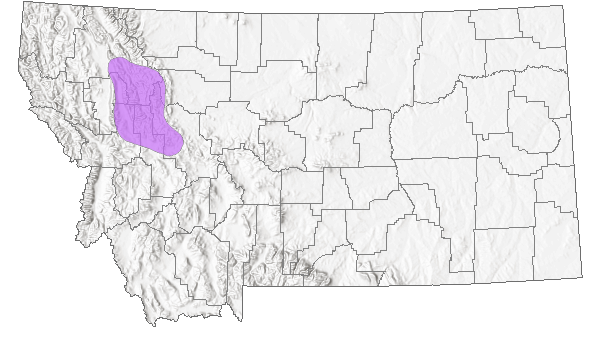
 Native
Native
Range Comments
Boreal Canada south to ME, WI, and MT. Peripheral. In North America, this species is found primarily in the Great Lakes region and farther east (Rice 2019).
Populations of Drosera linearis that are found in Montana are remarkably remote and often take days to hike into (Rice 2019).
Observations in Montana Natural Heritage Program Database
Number of Observations: 14
(Click on the following maps and charts to see full sized version)
Map Help and Descriptions
Relative Density
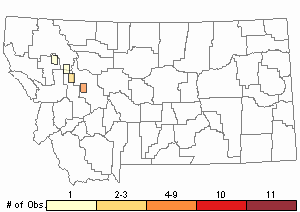
Recency
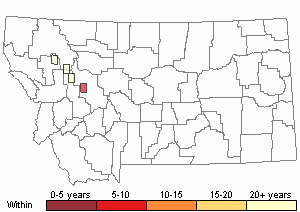
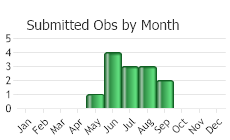
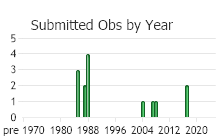
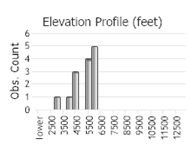 (Observations spanning multiple months or years are excluded from time charts)
(Observations spanning multiple months or years are excluded from time charts)
Habitat
Wet, organic soil of nutrient-poor fens in the montane zone. May also occur on lake margins (Rice 2019).
National Vegetation Classification System Groups Associated with this Species
Wetland and Riparian
Peatland
Food Habits
Drosera linearis traps and digests mosquitoes, damsel flies, and other insects (Stromberg-Wilkins 1984).
Ecology
HYBRIDIZATION
Drosera anglica most likely originated as a hybrid of D. linearis x D. rotundifolia (Wood 1955; Hoyo et al. 2015).
ASSOCIATED SPECIES
Usual associates with Slenderleaf Sundew include Triglochin maritima, Carex chordorrhiza, Carex livida, Lobelia kalmia, and Utricularia minor (Stromberg-Wilkins 1984).
PREY CAPTURE
Prey insects are initially lured to plants by their brilliant red gland stalks (Wolf et al. 2006). This pigmentation may vary due to environmental effects such as sun exposure and inundation (Rice 2019). After landing or climbing onto the leaves, prey get stuck to the longer, trapping glands on the margins of the leaves which hold them in place while the shorter glands secrete digestive enzymes (Lloyd 1942). A bending of the leaf petiole to fold the leaf over itself also assists in keeping prey in place once entrapment has occurred (Darwin 1897).
POPULATION DYNAMICS
Populations of Slenderleaf Sundew examined in Wisconsin have shown a short half-life, rapid turnover of individuals, and unstable growth rates (Stromberg-Wilkins 1984). This suggests that populations are vulnerable to frequent local extinctions. Environmental events that limit seed production such as flooding may threaten population growth. However, it is hypothesized that Slenderleaf Sundew may overcome these incidents by persisting for a season in seed form.
Reproductive Characteristics
All three Drosera species can reproduce both sexually and vegetatively (Hoyo et al. 2015; Murza et al. 2003). Sexual reproduction is almost exclusively done through self-pollination leading to most offspring being genetically identical to parent plants whether they reproduce sexually or vegetatively (Wolf et al. 2006).
Slenderleaf Sundew reproduces asexually (vegetatively) by producing new raments that sprout from the plants. This occurs when leaf buds separate and form plantlets or when axillary buds form beneath rosettes and then detach when the connecting stem decays (Stromberg-Wilkins 1984).
FRUITS and SEEDS [Lesica et al. 2012; Giblin et al. [eds.] 2018]
Fruits are many-seeded capsules that are 3-5 mm long. Seeds are 0.5-0.8 mm long, rhomboidal, bowl-shaped, and rounded at the tip.
FLOWERS [Lesica et al. 2012; Stromberg-Wilkins 1984]
Each flower has a 5-lobed calyx that is 4-5 mm long and 5 separate, oblong, white petals that are usually about 6 mm long. There are 5 stamens and 4-5 styles, which are divided more than half their length. Slenderleaf Sundew is predominantly self-pollinating. Its flowers only stay open for about 3 hours total before they close and self-fertilize.
LIFE CYCLE [Stromberg-Wilkins 1984]
Expansion of winter buds begin in early spring to form a rosette of up to eight leaves. The plants flower in mid-summer and seeds ripen in approximately one month. Seeds germinate in late summer and throughout the next growing season and may reproduce sexually or asexually when one year old.
Management
Preservation of Slenderleaf Sundew populations requires landscape level efforts to minimize human impacts (Stromberg-Wilkins 1984). It has disappeared from apparently pristine sites due to nearby human disturbance and changing landscape dynamics. Protection of historical sites that have existing seed banks may help re-establishment other populations. However, these sites must be closely monitored for changing water levels due to the particular hydrological conditions in which Slenderleaf Sundew seeds are able to germinate.
Cultivation of Slenderleaf Sundew is very difficult compared to other species in this genus. Introduction, even to suitable habitat, is not a reasonable method for management (Rice 2019).
Stewardship Responsibility
Threats or Limiting Factors
It is suggested that Slenderleaf Sundew possesses a particularly narrow niche, making it more vulnerable to hydrological impacts and changes in water chemistry than other wetland species existing in the same habitats (Stromberg-Wilkins 1984). It also germinates in a narrower range of water potentials making population sizes very sensitive to flooding events. Alteration of habitat to agricultural uses is also a major threat to populations.
STATE THREAT SCORE REASON
Reported threats to Montana's populations of Slenderleaf Sundew are currently assigned as unknown (MTNHP Threat Assessment 2021). Hiking recreation is indicated to be a potential threat to Slenderleaf Sundew or its habitat. Information about the scope and timing of this threat is needed to assess its relative risk to populations.
References
- Literature Cited AboveLegend:
 View Online Publication
View Online Publication Lesica, P., M.T. Lavin, and P.F. Stickney. 2012. Manual of Montana Vascular Plants. Fort Worth, TX: BRIT Press. viii + 771 p.
Lesica, P., M.T. Lavin, and P.F. Stickney. 2012. Manual of Montana Vascular Plants. Fort Worth, TX: BRIT Press. viii + 771 p. MTNHP Threat Assessment. 2021. State Threat Score Assignment and Assessment of Reported Threats from 2006 to 2021 for State-listed Vascular Plants. Botany Program, Montana Natural Heritage Program, Helena, Montana.
MTNHP Threat Assessment. 2021. State Threat Score Assignment and Assessment of Reported Threats from 2006 to 2021 for State-listed Vascular Plants. Botany Program, Montana Natural Heritage Program, Helena, Montana.
- Additional ReferencesLegend:
 View Online Publication
View Online Publication
Do you know of a citation we're missing? Lesica, P., K. Lackschewitz, J. Pierce, S. Gregory and M. O'Brien. 1986. Noteworthy collections: Montana. Madrono 33:310-312.
Lesica, P., K. Lackschewitz, J. Pierce, S. Gregory and M. O'Brien. 1986. Noteworthy collections: Montana. Madrono 33:310-312. Lesica, P., M.T. Lavin, and P.F. Stickney. 2022. Manual of Montana Vascular Plants, Second Edition. Fort Worth, TX: BRIT Press. viii + 779 p.
Lesica, P., M.T. Lavin, and P.F. Stickney. 2022. Manual of Montana Vascular Plants, Second Edition. Fort Worth, TX: BRIT Press. viii + 779 p. Rice, Barry A. 2019. The Genus Drosera L. (Droseraceae) in the western USA. March 21. Phytologia 101(1).
Rice, Barry A. 2019. The Genus Drosera L. (Droseraceae) in the western USA. March 21. Phytologia 101(1).
- Web Search Engines for Articles on "Slenderleaf Sundew"





